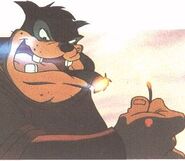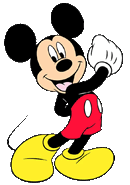| [Source] |
Walt Disney is the founder of the Disney company. He also is the creator and original voice actor of Mickey Mouse, Minnie Mouse, Pete and many other characters.
Early Life
Childhood
Disney was born on December 5, 1901, at 2156 North Tripp Avenue in Chicago's Hermosa community area to Elias Disney, who was Irish-Canadian, and Flora Call Disney, who was of German and English descent. His great-grandfather, Arundel Elias Disney, had emigrated from Gowran, County Kilkenny, Ireland where he was born in 1801. Arundel Disney was a descendant of Robert d'Isigny, a Frenchman who had travelled to England with William the Conqueror in 1066. With the d'Isigny name anglicized as "Disney", the family settled in a village now known as Norton Disney, south of the city of Lincoln, in the county of Lincolnshire.
In 1878 Disney's father Elias had moved from Huron County, Ontario, Canada to the United States, at first seeking gold in California before finally settling down to farm with his parents near Ellis, Kansas, until 1884. Elias married Flora Call on January 1, 1888, in Acron, Florida, just 40 miles north of where Walt Disney World would ultimately be developed.The family moved to Chicago, Illinois in 1890, hometown of Elias' brother Robert, who helped Elias financially for most of Walt's early life. In 1906, when Walt was four, Elias and his family moved to a farm in Marceline, Missouri, where his elder brother Roy had recently purchased farmland. In Marceline, Disney developed his love for drawing with one of the family's neighbors, a retired doctor named "Doc" Sherwood, paying him to draw pictures of Sherwood's horse, Rupert. Elias was a subscriber to the Appeal to Reason newspaper and Walt copied the front-page cartoons of Ryan Walker. His interest in trains originated in Marceline as well. There was a railway called Atchison, Topeka and Santa Fe Railway which passes near the neighbourhood. Upon hearing the train whistle, Walt and Roy would run to a clearing of high ground. Once recognised by their uncle, Mike Martin, who conducted the train, he would wave and produce a long whistle, followed by two short ones. That functioned as a signal to the brothers.
10-year old Walt Disney (center right) at a gathering of Kansas City newsboys in 1912.
Walt attended the new Park School of Marceline in fall, 1909. He and his younger sister Ruth started school together. Before that he had no formal schooling. The Disneys remained in Marceline for four years, until having to sell their farm on November 28, 1910. At that time, two of Walt's elder brothers, Herbert and Ray, had been fed up with the constant work and little or no spending money, and ran away in fall 1906. Afterwards the family moved to Kansas City in 1911,where Walt and Ruth attended the Benton Grammar School at 3004 Benton Boulevard, close to his new home. Disney had completed the second grade at Marceline but had to repeat the grade at Kansas City. At school he met Walter Pfeiffer, who came from a family of theatre aficionados and introduced Walt to the world of vaudeville and motion pictures. Before long, Walt was spending more time at the Pfeiffers' than at home, as well as attending Saturday courses at the Kansas City Art Institute,
On July 1, 1911, Elias purchased a newspaper delivery route for The Kansas City Star. It extended from the Twenty-seventh Street to the Thirty-first Street, and from Prospect Avenue to Indiana Avenue. Roy and Walt were put to work delivering the newspapers. The Disneys delivered the morning newspaper Kansas City Times to about 700 customers and the evening and Sunday Star to more than 600. The number of customers they had increased with time. Walt woke up at 4:30 AM and worked delivering newspapers until the school bell rang. He resumed working the paper trail at 4PM and continued to supper time. He found the work exhausting and often received poor grades from dozing off in class. He continued his paper routine for more than six years.
Teenage Years
In 1917 Elias acquired shares in the O-Zell jelly factory in Chicago and moved his family back to the city.[24] In the fall Disney began his freshman year at McKinley High School and took night courses at the Chicago Academy of Fine Arts under the tutelage of artist and educator Louis Grell (1887–1960). He became the cartoonist for the school newspaper, drawing patriotic topics on World War I. With a hope to join the army, Disney dropped out of high school at the age of sixteen, but was rejected for being under-age. Afterwards, Disney and a friend joined the Red Cross. He was soon sent to France for a year, where he drove an ambulance, but only after the armistice was signed on November 11, 1918.
Disney as an ambulance driver immediately after World War I
Hoping to find work outside the Chicago O-Zell factory,Walt moved back to Kansas City in 1919 to begin his artistic career. He considered becoming an actor, but decided to draw political caricatures or comic strips for a newspaper. When nobody wanted to hire him as either an artist or as an ambulance driver, his brother Roy, then working in a local bank, got Walt a temporary job through a bank colleague at the Pesmen-Rubin Art Studio, where he created advertisements for newspapers, magazines, and movie theaters.[31] At Pesmen-Rubin he met cartoonist Ubbe Iwerks and, when their time at the studio expired, they decided to start their own commercial company together.
Awards
Walt Disney currently holds the record for both the most Academy Award nominations (59) and the number of Oscars awarded (22). He also earned four honorary Oscars.
The awards he won include:
- 1932: Best Short Subject, Cartoons: Flowers and Trees (1932)
- 1932: Honorary Award for creation of Mickey Mouse
- 1939: Honorary Award for Snow White and the Seven Dwarfs (1937) The citation read, "For Snow White and the Seven Dwarfs, recognized as a significant screen innovation which has charmed millions and pioneered a great new entertainment field." (The award, unique in the history of the Oscars, is one large statuette and seven miniature statuettes.)
- 1941: Honorary Award for Fantasia (1940), shared with: William E. Garity and J.N.A. Hawkins. The citation for the certificate of merit read, "For their outstanding contribution to the advancement of the use of sound in motion pictures through the production of Fantasia."
- 1943: Best Short Subject, Cartoons: Der Fuehrer's Face (1942)
- 1949: Irving G. Thalberg Memorial Award (Honorary Award)
- 1951: Best Short Subject, Two-reel: In Beaver Valley (1950)
- 1952: Best Short Subject, Two-reel: Nature's Half Acre (1951)
- 1954: Best Documentary, Features: The Living Desert (1953)
- 1954: Best Short Subject, Cartoons: Toot Whistle Plunk and Boom (1953)
- 1959: Best Short Subject, Live Action Subjects: Grand Canyon (1958)
- 1969: Best Short Subject, Cartoons: Winnie the Pooh and the Blustery Day (1968)
Gallery
| This page uses Creative Commons Licensed content from Wikipedia (view authors). |






